|
IPMS Memphis
Classic Airframes
Kit Contest
|
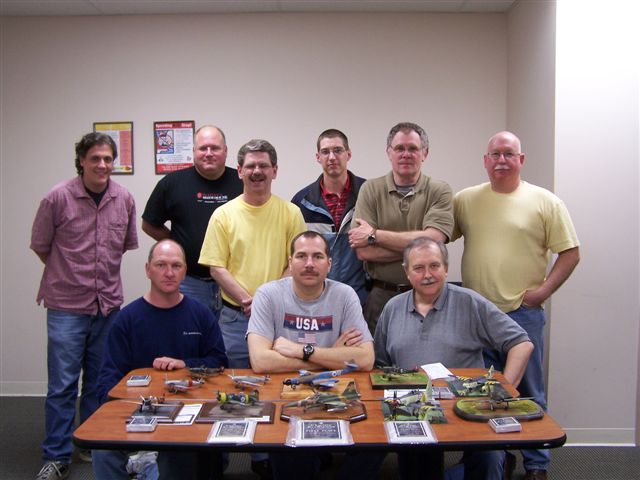 |
|
IPMS Memphis members with their Classic Airframes models |
by Roger Rasor

Classic Airframes' 1/48 scale Messerschmitt Bf 109 C/D is
available online from Squadron
Each year, the IPMS-Memphis (Tennessee) Chapter
schedules three club competitions that focus members’ skills on a
specific theme or challenge. The 2006 March contest challenged members
to build any of the kits marketed by Classic Airframes. The members of
this aircraft-oriented chapter met the challenge in their usual way, by
sharing their in-progress project work at the January and February
meetings and displaying a table-full of finished models at the March
meeting.
Classic
Airframes Kit Contest
|
Members’ individual interests were demonstrated in
subjects that ranged from pre-WW II single prop to Vietnam-era jet, and
included some of the Classic Airframes’ earlier kit offerings as well as
more current ones. Competition was stiff and judging took a little
longer than usual. When the points were totaled, a South Vietnamese Air
Force F-5A Skoshi Tiger by Richard Van Zandt took first place honors, a
Brewster Model 239, in Finish markings, built by honorary chapter member
(and IPMS Region 3 Coordinator) Phil Hale took second place and a
Westland Wyvern, in Suez Crisis markings, by Scott Doyle took third
place. Four others received special commendation. They included a
Luftwaffe Bf-109B by Bill VonStaden, an IJN A5M-4 Claude by Kevin
Wilson, a Royal Navy Hawker Sea Hawk by Roger Rasor and an RAF Mk. I
Hawker Hurricane built by Jim Webb.
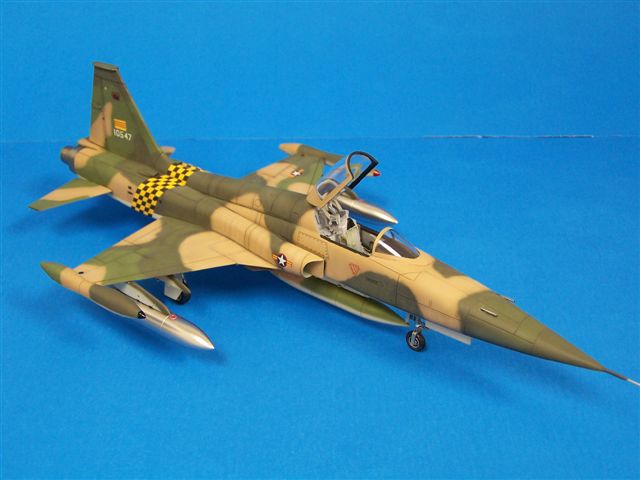
After the awards presentation, the modelers described their builds to
the whole group. In commenting on his F-5A, Rich Van Zandt said his
previous experience building the similar Sword T-38 kit served him well
as he built the Classic Airframes release. Rich used Gunze and Alclad
paints and kit decals to finish the model and he was very happy with the
finished results.
In discussing his Finish Model 239, Phil Hale said that he enjoyed
building what turned out to be his third Classic Airframes Brewster
Buffalo kit…especially since he built this one for himself. HyperScale
visitors who are familiar with Phil’s work will not be surprised at the
highly realistic finish and weathering on his latest Brewster.
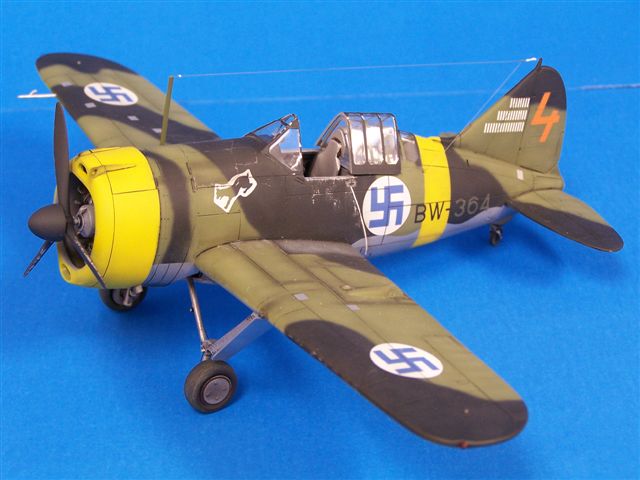
Scott Doyle noted that when he opened the Wyvern kit box, he was
impressed with the contents inside. He said that he found a little bit
of everything in this multimedia kit and, as can be imagined, alignment
was the most difficult part of the build. Since there were no locating
pins, it was necessary to carefully sand the butt joints for the
horizontal stabilizers to achieve the proper 100 Angle, and Scott found
it was necessary to fill and rescribe the multiple-piece vertical
fin/rudder assembly to match the prototype. Scott said he also spent
more time test fitting and aligning everything than is necessary with
the average Tamiya kit and he warned that with an aircraft as complex as
the Wyvern, reference material (like the soft cover 4+ Plus book) is a
must.
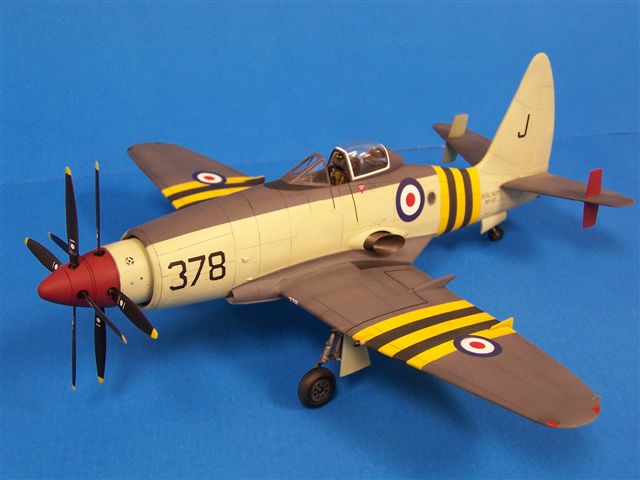
Bill Von Staden jumped at the opportunity to build Classic Airframes’
recently released Bf-109 A/B kit. After building the Hobbycraft
versions, the club’s resident Luftwaffe ‘Experten’ said the new kit was
hands down the way to go for anyone wanting to build an accurate replica
of an early 109. Bill said the build went smoothly and he felt that this
kit comes closest to matching the fit and ease-of-assembly of most
mainstream kits. The only real slowdown he experienced was when fitting
the resin cowling to the fuselage. Bill experienced problems with the
new Vallejo paints. Bill said that, when dry, the paint did not seem to
adhere well to the surface of the plastic. So in the end, he resorted to
using the tried-and-true Gunze RLM colors to replicate the finish on his
Bf-109B. The results were striking.
Kevin Wilson finished Classic Airframes’ Mitsubishi A5M Claude kit in
the vivid late-1930’s amber-colored varnished finish. Kevin said he
spent quite a bit of time dry fitting components, filling seams and
rescribing a number of panel lines before painting. To achieve the
finish, Kevin airbrushed a light mist of an Alclad Aluminum/Gunze Gold
mix over an Alclad basecoat and then used the kit decals. The paint
scheme was definitely a showstopper! Since Kevin built this one from one
of CA’s earlier releases, which lacks some of the refinements of their
latest offerings, everyone was duly impressed.
Before assembling the Hawker Sea Hawk kit, Roger Rasor spent some extra
time preparing the four-piece fuselage mating surfaces, carving out the
gun ports and adjusting the fit of the resin castings into their
respective locations. Roger said that he did not miss the missing
locating pins. The horizontal tail planes fit nicely into the fin slot
and he added evergreen styrene strips to the backside of the fuselage
and wing parts before he mated them to one another to assure a firm and
aligned attachment. He used a little Tamiya putty during the build and
added a substantial number of small lead weight pieces to any and all
nose cavities to keep the model from sitting on its tail hook. When
finished, Roger said he enjoyed the challenges of building Classic
Airframes’ kit of what he considers to be one of the most aesthetically
pleasing jets ever to fly.
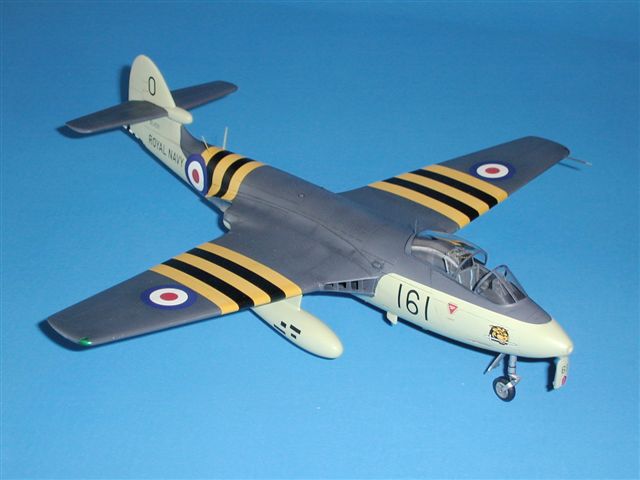
Jim Webb reported that, like others, he found the lack of locating pins
on the Classic Airframes Hurricane kit to be the most challenging part
of the build. Otherwise, the build was straightforward and Jim then
finished the model in the kit’s early Battle of Britain camouflage
scheme with the split white/black underside. Like Bill, Jim also
experienced problems with the new Vallejo paints not adhering well to
the plastic. Jim wasn’t sure whether it was the paint or the shinny
surface of the plastic, but he found it necessary to touch up some areas
of his paint job three times before he completed the model.
As the chapter members surveyed the results of their first 2006 club
contest, everyone felt a little more satisfaction than usual with both
the finished products and the whole experience. They expressed
appreciation that Classic Airframes markets such a wide variety of
aircraft subjects that each member was able to select a personal
favorite while meeting the contest challenge. They acknowledged that
building Classic Airframes kits did require a little more planning,
preparation and skill than the typical build. But, all agreed that it
was rewarding to see a table full of competitive models built from
limited run kits that challenged everyone’s modeling skills.
The real proof of that shared opinion was born out at
the IPMS-Memphis April club meeting when two of the newest in-progress
models brought to the meeting were being built from more Classic
Airframes kits. Thank you Jules!
Click the
thumbnails below to view larger images:
Text Copyright ©
2006 by Roger Rasor
Images Copyright © 2006 by Phil Hale
Page Created 20 April, 2006
Last Updated
20 April, 2006
Back to
HyperScale Main Page |
Home
| What's New |
Features |
Gallery |
Reviews |
Reference |
Forum |
Search